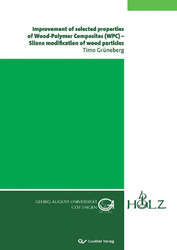| Fachbereiche | |
|---|---|
| Buchreihen (96) |
1378
|
| Nachhaltigkeit |
3
|
| Gesundheitswesen |
1
|
| Geisteswissenschaften |
2364
|
| Naturwissenschaften |
5406
|
| Mathematik | 229 |
| Informatik | 319 |
| Physik | 980 |
| Chemie | 1363 |
| Geowissenschaften | 131 |
| Humanmedizin | 243 |
| Zahn-, Mund- und Kieferheilkunde | 10 |
| Veterinärmedizin | 108 |
| Pharmazie | 147 |
| Biologie | 835 |
| Biochemie, Molekularbiologie, Gentechnologie | 121 |
| Biophysik | 25 |
| Ernährungs- und Haushaltswissenschaften | 45 |
| Land- und Agrarwissenschaften | 1004 |
| Forstwissenschaften | 201 |
| Gartenbauwissenschaft | 20 |
| Umweltforschung, Ökologie und Landespflege | 148 |
| Ingenieurwissenschaften |
1793
|
| Allgemein |
98
|
|
Leitlinien Unfallchirurgie
5. Auflage bestellen |
|
Erweiterte Suche
Improvement of selected properties of Wood-Polymer Composites (WPC) – Silane modification of wood particles
Timo Grüneberg (Autor)Vorschau
Inhaltsverzeichnis, Datei (53 KB)
Leseprobe, Datei (420 KB)
Wood Polymer Composites are a new group of hybrid materials, which combine the advantages
of synthetic polymers such as polyolefines and natural polymers such as wood; whereas the
synthetic polymer is used as matrix material and the wood as reinforcement material or filler. As
matrix material, principally every thermoplastic polymer with a processing temperature below
200°C can be used due to the temperature sensivity of wood. Wood Polymer Composites are
processed typically with processing technologies from the plastic industry such as extrusion and
injection molding.
The present study was conducted to explore the possibility of wood particle modification with
different types of silanes. It was the aim to contribute the silanes as compatibilizers or coupling
agent and therefore improve the mechanical properties and the resistance against water. Norway
spruce (Picea abies) as representative wood species was used in three different particle types. The
size distribution for the wood particles ranges from 70-2500 µm. Four commercial available
silanes with various functional groups (amino, di-amino, alkyl) were used as modification agents.
The concentrations varied between 1.5%, 3.0%, 4.5% and 7.5%. As reference system commonly
used maleated acid anhydride based coupling agents were used. The pre-treated wood particles
were compounded via extrusion with polypropylene and samples were produced via injection and
compression molding. The following properties were tested; tensile, bending, and impact
strength, water uptake (cold and boiling water test), descent rate, weathering tests and durability
test against basidiomycetes.
SEM-EDX investigations proved the presence of silane either in the cell wall structure, or on the
wood particle surface. Due to the structure and the functionality of the silanes it was expected
that the silane treated wood particles are able to improve the mechanical properties. It was shown
that the silanes had no significant effect as compatibilizer or coupling agent.
The mechanical properties strongly increase with the usage of coupling agent. Both coupling
agents were based on maleic acid anhydride grafted on a polymer backbone, whereas Type I
reaches an optimum regarding the mechanical properties at 3%, the coupling agent Type II still
improves the mechanical properties up to a ratio of 4.5% with no clear optimum. The silane pretreatment
influences the improvement not significantly, compare to the improvement caused by
the coupling agent.
The used wood particles showed mechanical degradation during the compounding process. The
biggest degradation was monitored for the wood particles of Lignocel® Type 9. Due to its fine
structure it can be assumed that the Arbocel® C100 wood particles consist of only cell wall
fragments of the wooden cell wall, which express a better resistance against mechanical
destruction during the process.
The Wood Polymer Composites showed a lower decay rate compared to solid wood. The
moisture content within the Wood Polymer Composite samples ranges at the low optimum level
for fungi attack and were not significantly improved by an accelerated wetting before the test.
The core remains relatively dry. The main protection seems to come from the encapsulation by
the polymer.
The weathered Wood Polymer Composite samples showed a strong color change within a
relatively short period of exposure. The color changed independently from the silane type or the
silane ratio. Also an increase of cracks and gaps on the sample surface was observed compared to
the unexposed sample and the pure polymer reference.
| ISBN-13 (Printausgabe) | 3869555610 |
| ISBN-13 (Printausgabe) | 9783869555614 |
| ISBN-13 (E-Book) | 9783736935617 |
| Buchendformat | A5 |
| Sprache | Englisch |
| Seitenanzahl | 196 |
| Umschlagkaschierung | matt |
| Auflage | 1 Aufl. |
| Band | 0 |
| Erscheinungsort | Göttingen |
| Promotionsort | Universität Göttingen |
| Erscheinungsdatum | 22.11.2010 |
| Allgemeine Einordnung | Dissertation |
| Fachbereiche |
Forstwissenschaften
|
| Schlagwörter | Kunstofftechnik, Polymerverarbeitung |








